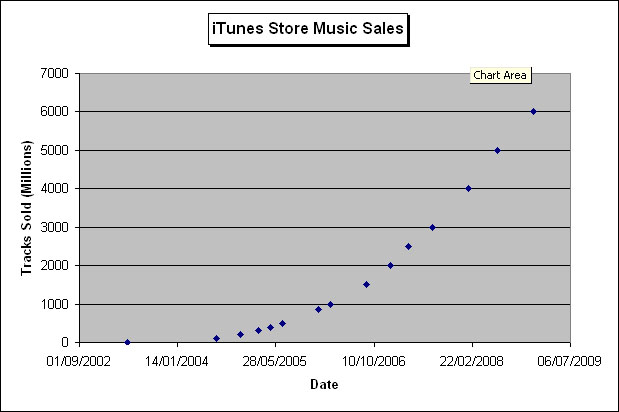Digital Music Stores Compared
A lot of people get in touch with us to ask how many digital stores we distribute music to, and what proportion of the digital music market they represent. We also hear comments on the relatively small number of people we deal with in comparison to the huge lists of partners at some of our competitors, e.g. CDbaby, Emubands, IODA…(without mentioning the duplication in the last two).
The simple truth is that while a long list of digital music stores might look good, beyond the top 3 or 4 retailers it makes very little difference to overall sales how many your music’s in. It’s fairly common knowledge that iTunes is the biggest player in the market, but the scale of their dominance is pretty staggering. Neilsen (the ratings and market reporting firm) reports total US music sales of 1,513 million units in 2008, with 1070 million of those sales being digital downloads. That’s a billion digital music downloads across the entire US.
In 2008, across all territories, iTunes sold more than Two Billion tracks.
| Apple iTunes Store Music Sales | |
| Date | Tracks Sold (Millions) |
| 01/08/2004 | 100 |
| 16/12/2004 | 200 |
| 02/03/2005 | 300 |
| 10/05/2005 | 400 |
| 18/07/2005 | 500 |
| 10/01/2006 | 850 |
| 23/02/2006 | 1,000 |
| 12/09/2006 | 1,500 |
| 10/01/2007 | 2,000 |
| 09/04/2007 | 2,500 |
| 31/07/2007 | 3,000 |
| 15/01/2008 | 4,000 |
| 19/06/2008 | 5,000 |
| 06/01/2009 | 6,000 |
Excuse the horrid old excel graph, I’m still running Office ’03…

It’s difficult to get a believable estimate for the size of the global digital music market, but given that the USA is the biggest single economy by a long way (the whole of the EU only just beats it in the CIA factbook at $14.98 trillion to $14.58 trillion), you begin to get a picture of how much of a monopoly iTunes has. Their competitors are of a different order: Amazon weighed in at 27 million digital tracks sold in the first six months of 2008, and the CEO of eMusic (David Pakman) estimated that Amazon have got about 4%-5% of the US music market, which going from Neilsen’s estimates puts them at about 48,150,000 tracks annually. Pakman also claims an approx. 10%-15% market share for eMusic, with 7 million downloads sold monthly (7*12 = 84).
By browsing eMusic’s sales milestone press releases, you can plot a rough course for their sales:
| eMusic Digital Music Sales | |
| Date | Tracks Sold (Millions) |
| 01/09/2004 | 0 |
| 01/12/2004 | 3 |
| 01/12/2006 | 100 |
| 25/09/2007 | 160 |
| 14/04/2008 | 200 |
| 20/11/2008 | 250 |
I’ll spare you another ugly graph. eMusic has sold 250 million tracks since it’s relaunch in 2004, and Amazon’s only been going for about a year now, 300 million tracks let’s say, which pales beside iTunes’ 6 billion total sales.
One can argue with the estimates, but the main thrust of my argument is hopefully becoming clear. A conservative 15% market share between Amazon and eMusic, along with iTunes’ >80% doesn’t leave more than 5% for any other players in the USA: with just those three selling your music for you online, you’ve got 95% of the market covered. It’s not that the remaining 5% isn’t worth catering to, but the law of diminishing returns kicks in, and customers in the last few percentiles get harder and harder to chase down, especially given the plethora of blossoming and failing little music shops that appear and dissappear. We concentrate our efforts on the vendors that matter.
P.S.
The controversial bulk of music discovery and consumption in the electronic wilderness, outside the paid-for enclosure, is happening on torrent sites like the embattled Pirate Bay, and the more respectable Limewire and Mininova, and promoting RouteNote artists on these channels is something we’re looking into. Ubiquitous innovator Trent Reznor or NIN positively encourages people to download his music from P2P networks, in order to drive sales of his ‘premium’ paid for content.